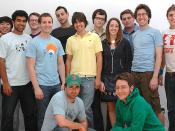A good compensation plan must include both aspects, financial and nonfinancial of a rewarding system where financial rewards, or a pay system, "assign a monetary value to each job in the organization (a base rate) and an orderly procedure for increasing the base rate (e.g., based on merit, inflation, or some combination of the two)" (Cascio, 2005, p. 425). Also, "a properly designed Pay for Performance (PFP) Program enables companies to reduce their cost of labor while increasing the average take home pay of their workforce" (Jensen, 2009). On the other hand we also will offer nonfinancial systems that will cover indirect aspects such as benefits, professional and personal development. We want to give our "sales staff a reason to get out there and sell, sell, sell" (Ward).
"Rewards bridge the gap between organizational objectives and individual expectations and aspirations. To be effective, organizational reward systems should provide four things: (1) a sufficient level of rewards to fulfill basic needs, (2) equity with the external labor market, (3) equity within the organization, and (4) treatment of each member of the organization in terms of his or her individual needs" (Cascio, 2005, p.
419).
New compensation plan"Pay systems are designed to attract, retain, and motivate employees" (Cascio, 2005, p. 419)The new compensation plan will be based in a performance system. "If business takes off, more pay goes to workers. If it doesn't, the company is not locked into high fixed costs of labor. 417" This system was chosen since meets the company strategy of growth and objectives and "such variable-pay systems almost guarantee cost control. 417 (Cascio, 2005, p. 417)" and a well planed recognition system adds to the compensation plan to offset a higher level of discouragement found in a competitive selling environment and also "can be used to express...


